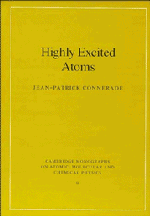Book contents
- Frontmatter
- Contents
- Preface
- 1 Closed shells, sphericity, stability and ‘magic numbers’
- 2 Rydberg states
- 3 Quantum defect theory for bound states
- 4 Atomic f values
- 5 Centrifugal barrier effects
- 6 Autoionisation
- 7 Inner-shell and double-excitation spectra
- 8 K-matrix theory of autoionising resonances
- 9 Atoms in strong laser fields
- 10 Statistical methods and ‘quantum chaology’
- 11 Atomic effects in solids
- 12 Atomic clusters
- References
- Index
6 - Autoionisation
Published online by Cambridge University Press: 19 September 2009
- Frontmatter
- Contents
- Preface
- 1 Closed shells, sphericity, stability and ‘magic numbers’
- 2 Rydberg states
- 3 Quantum defect theory for bound states
- 4 Atomic f values
- 5 Centrifugal barrier effects
- 6 Autoionisation
- 7 Inner-shell and double-excitation spectra
- 8 K-matrix theory of autoionising resonances
- 9 Atoms in strong laser fields
- 10 Statistical methods and ‘quantum chaology’
- 11 Atomic effects in solids
- 12 Atomic clusters
- References
- Index
Summary
Beutler–Fano resonances
The photoionisation continuum of H is clean and featureless. Its intensity declines monotonically with increasing energy. Many-electron systems, in general, always exhibit structure embedded in the continuum. Such features are neither purely discrete nor purely continuous, but of mixed character, and are referred to as autoionising resonances. They were discovered experimentally by Beutler [254], and the asymmetric lineshape which they can give rise to follows a simple analytic formula derived by Fano [256]. For this reason, they are often referred to as Beutler–Fano resonances. A typical autoionising resonance is shown in fig. 6.1
Autoionisation is a correlation effect. It occurs for all many-electron atoms in highly-excited configurations which lie above the first ionisation threshold. Many spectra used as illustrations in the present volume provide examples of autoionising lines (see in particular chapter 7).
The origin of autoionising structure can be either of the following mechanisms or a combination of both. First, it is possible to excite more than a single electron at a time. Although forbidden in the independent particle model of the atom, many-electron excitation is physically possible, and indeed likely. It provides tangible evidence that the independent particle model is only an approximation. The fact that double excitation can give rise to very intense resonances shows that the breakdown of the independent particle model is by no means a small or negligible effect. The magnitude of this breakdown depends on the proximity in energy between single and double excitations.
- Type
- Chapter
- Information
- Highly Excited Atoms , pp. 187 - 217Publisher: Cambridge University PressPrint publication year: 1998



